
Judith Webb | Soundview Cockers Cocker Spaniels
Judith Webb is the breeder behind Soundview Cockers Cocker Spaniels. Read about the kennel’s beginnings, puppies, and more!

Home » Dog Breeds » Cocker Spaniel Dog Breed
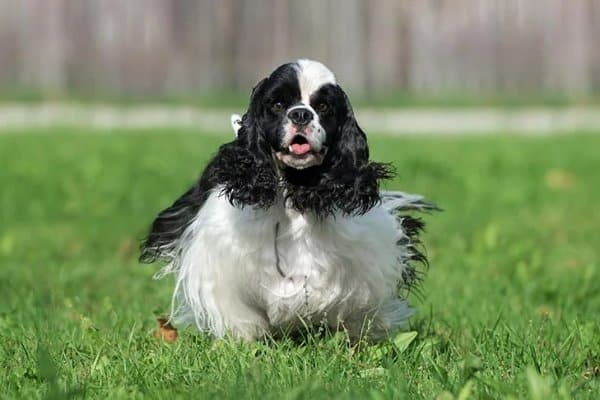
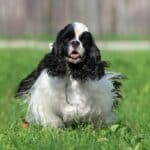
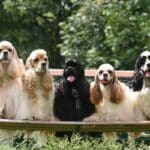
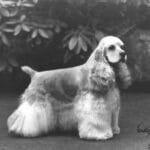
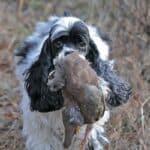
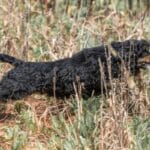
The Cocker Spaniel, often referred to as the “American Cocker” or simply as the “Cocker,” is cherished for its sweet demeanor, expressive eyes, and luxuriant coat. The smallest member of AKC’s Sporting Group, the breed has captured the hearts of millions, making this determined little field dog a popular choice for families in the United States and around the world.
Sporting
13.5 – 15.5 Inches
20 – 30 Pounds
10 – 14 Years
| Country of Origin | United States |
|---|---|
| Bred For | Flushing & Retrieving Birds, Companionship |
| Known For | Chiseled Head, Appealing Expression, Silky Coat, Sweet Nature |
| Popularity | High |
| Temperament | Smart, Happy, Gentle |
| Activities | Hunting, Running, Therapy Dog, Conformation Shows, Dog Sports |
The Cocker Spaniel has a rich lineage that dates back centuries. The breed’s journey from avid bird hunter to treasured household companion is truly fascinating.
The breed’s name provides a hint to its origins. Cocker Spaniels were originally bred in England to hunt the Eurasian woodcock, a type of game bird, which led to the name “Cocker.” They are part of the larger spaniel family, a group of breeds known for their exceptional hunting skills, particularly in flushing game from hiding spots.
By the 19th century, land spaniels in England were categorized by their size and the game they hunted rather than their specific breed. It was only later that specific Breed Standards were established, dividing spaniels into separate breeds. Among these, the Cocker Spaniel was recognized for its smaller size and its particular prowess in hunting woodcocks.
The breed’s popularity soared when it made its way to the United States. American breeders started developing a slightly different version of the Cocker Spaniel, focusing on its potential as a show dog and companion rather than just as a hunter. This American variety became stockier, with a different head shape compared to its original English counterpart.
In 1946, due to these distinct differences, the American Kennel Club (AKC) recognized the English Cocker Spaniel and the American Cocker Spaniel as two separate breeds. Today, when people in the US refer to a “Cocker Spaniel,” they are typically referring to the “American” Cocker.
Throughout their history, Cocker Spaniels have been beloved by many, including several US presidents. Their gentle disposition, combined with their beautiful appearance, has kept them in the limelight both in show rings and in homes around the world.
The breed has also gained recognition from major international kennel clubs, including the Fédération Cynologique Internationale (FCI) and The Royal Kennel Club (UK).
Adult male Cocker Spaniels generally stand between 14.5 and 15.5 inches tall at the shoulder, while mature females typically range from 13.5 to 14.5 inches.
In terms of weight, males usually range from 25 to 30 pounds, while females tend to weigh between 20 and 25 pounds.
Cocker Spaniels are renowned for their sturdy, compact frame, which combines strength and agility in equal measure. They have a slightly sloping topline, strong back, well-sprung ribs, and muscular quarters. Their overall substance and balance complement their size, exuding a refined yet robust appearance.
Texture: The coat of the Cocker Spaniel is silky and either flat or slightly wavy. It is short and fine on the head, and of medium length on the body with a protective undercoat. Feathering on the ears, chest, abdomen, and legs gives the breed its distinctive appearance.
| Standard Color | |
|---|---|
| Black | ee |
| Black & Tan | ee |
| Silver | ee |
| Buff | ee |
| Red | ee |
| Brown | ee |
| Brown & Tan | ee |
| Black & White | ee |
| Red & White | ee |
| Buff & White | ee |
| Brown & White | ee |
| Black White & Tan | ee |
| Brown White & Tan | ee |
| Golden | ee |
| Blue Roan | ee |
| Blue Roan & Tan | ee |
| Sable | ee |
| Sable & White | ee |
| Cream | ee |
| Red Roan | ee |
| Brown Roan | ee |
| Brown Roan & Tan | ee |
| Standard Marking | |
|---|---|
| Roan | ee |
| White Markings | ee |
| Ticked | ee |
| Merle Markings | ee |
A Note About Color: The Black Variety includes black with tan points. The black must be a solid black with a healthy sheen. Tan points can range from light cream to dark red in color. Only a small amount of white on the chest and/or throat is acceptable. The Parti-Color Variety presents two or more solid and well-broken colors, one of which must be white, and includes roans as well as tan points. The ASCOB variety includes any solid color other than black, although lighter feathering is acceptable. Only a small amount of white on the chest and/or throat is acceptable.
When the dog is in its natural stance, the tail is set as an extension of the topline. It is carried horizontally or at a slight upward angle, but is never raised high above the back. The tail showcases the breed’s enthusiastic demeanor, especially when it wags for pleasure or attention.
Historically, the Cocker Spaniel’s tail has been docked, primarily to prevent injury when working in the field. However, docking practices today vary by country and even within jurisdictions. When left undocked, the tail is of medium length and feathered, and still maintains its characteristic lively action.
The Cocker Spaniel, often dubbed the “Merry Cocker,” is a delightful companion known for its affectionate nature and playful demeanor. Owning one of these dogs can be a rewarding experience, but there are a few special considerations to keep in mind. Their sporting background as a hunter means they are active and require regular exercise. Furthermore, their luxurious coat, while beautiful, demands consistent grooming to keep it in top condition. It’s essential, therefore, to understand and cater to the breed’s specific needs to ensure both the Cocker and its family will lead a happy life together.
Cocker Spaniels, like all breeds and mixed breeds, come with their own set of health concerns. However, with appropriate care they are generally known to lead full and vibrant lives. Regular veterinary check-ups, a nutritious diet, consistent exercise, and a keen awareness of the breed’s specific health issues can substantially enhance the overall well-being and longevity of any Cocker.
Lifespan: On average, a well-cared-for Cocker Spaniel can expect a lifespan of 10 to 14 years, positioning them as one of the longer-lived breeds within the AKC Sporting Group.
Cocker Spaniels are generally robust and healthy, but like many dogs, they can be prone to certain health conditions. Some of the common issues associated with the breed include:
In addition to being vigilant about the above conditions, routine veterinary check-ups are paramount. Regular visits allow for early detection of potential health problems, ensuring that the Cocker Spaniel enjoys a healthy and active life for many years.
The Cocker Spaniel is often described as a breed with a “merry” temperament, radiating joy, warmth, and a zest for life. These dogs are known for their sociable and affectionate nature, making them excellent companions for families and individuals alike.
For those new to dog ownership, the Cocker Spaniel can be a good choice. While they do have an active side due to their hunting background, their eager-to-please attitude makes them relatively adaptable and responsive to training. Novices, however, should be prepared for the grooming and exercise needs of this breed.
When it comes to sensitivity, the Cocker Spaniel is quite a sensitive soul. The breed thrives best in loving environments and can sometimes become anxious or timid if treated unfairly. Positive reinforcement is the way to go with this breed.
Being alone for extended periods isn’t ideal for Cocker Spaniels. They are social creatures and prefer the company of their human companions or other dogs. Speaking of other dogs, they generally get along well with their canine counterparts. Early socialization is beneficial to ensure they are also good with young children.
When meeting strangers, a well-socialized Cocker Spaniel is typically friendly and welcoming. However, early exposure to a variety of people and experiences can help to ensure they remain open and accepting of new faces.
Feeding a Cocker Spaniel requires a balance of nutrition that suits the breed’s active and energetic nature. These dogs typically have a moderate appetite; however, and tend to gain weight if not provided with the right amount and type of food and given periods of regular exercise.
For Cocker Spaniel puppies, the diet should be rich in proteins and fats to support their growth and development. Puppies should be fed multiple small meals throughout the day, gradually reducing the number as they age. As they transition into adulthood, typically by 12 months, the Cocker’s diet can shift to adult dog food formulations.
An adult Cocker Spaniel will typically consume between 1.5 to 2.5 cups of high-quality dry dog food daily, divided into two meals. The exact amount may vary based on the dog’s age, metabolism, activity level, and overall health. Owners should monitor their dog’s weight and adjust portions accordingly to prevent overfeeding or not feeding enough.
It’s always important to ensure that a Cocker Spaniel has access to fresh water throughout the day. Also, treats can be given, but this should be done in moderation and accounted for in the dog’s total caloric intake.
Lastly, it’s always a good practice to consult with a veterinarian to tailor a feeding plan that meets the specific needs of your individual Cocker Spaniel.
Training a Cocker Spaniel is an experience filled with rewards and challenges. These dogs are known for their intelligence and eagerness to please, which makes them relatively easy to train, especially when started early. The breed’s keen sense of understanding and its responsive nature often mean the Cocker picks up commands quickly.
However, it’s important to remember that the Cocker Spaniel is a sensitive soul. Harsh training methods or negative reinforcement can lead to a timid or anxious dog. Positive reinforcement, using treats, praises, and toys, is the most effective way to guide them.
While Cocker Spaniels don’t have a high tendency to bark excessively, they might alert their owners with a bark when they notice someone at the door or when they hear any unfamiliar sounds. Training them with commands like “quiet” can help to manage this behavior.
In terms of intelligence, Cocker Spaniels rank high. Combined with their sporting background, this can sometimes lead to a bit of wanderlust. It’s crucial to provide secure fencing in the yard and always have the Cocker on a leash during walks. Early recall training is beneficial for this breed.
The breed’s ancestral instincts can also mean a higher prey drive. This doesn’t mean these hunting dogs can’t coexist with smaller pets, but early socialization and consistent training are essential to ensure harmonious relationships.
Born with a hunting heritage, the Cocker Spaniel possesses a notable degree of energy and stamina. Regular exercise is not just beneficial for the breed’s physical health but is also crucial for a dog’s mental well-being.
| Energy Level | Moderate |
|---|---|
| Exercise Requirements | 45-90 Minutes/Day, Daily Walks, Regular Exercise, Playing with Another Dog, Mental Stimulation |
Cocker Spaniels thrive on activities that engage both their body and mind. A brisk daily walk, combined with some playtime in the yard or a nearby park, will usually suffice for their exercise needs. Fetch, being one of their favorite games, can be a great way to allow them to sprint and release their pent-up energy.
In terms of intensity, while Cockers don’t require the same level of rigorous exercise as some high-energy breeds, they do appreciate a good run and play session. Their playful nature makes them a joy to engage in activities, and they’re always up for a game or two.
It’s worth noting that Cocker Spaniels, especially when young, can sometimes have bursts of energy, often referred to as “the zoomies,” where they run around with exuberance. These bursts are perfectly normal and are just their way of expelling excess energy.
Ensuring regular exercise for a Cocker Spaniel will not only keep this breed fit, it also helps to prevent potential behavioral issues that can arise from boredom or a lack of stimulation.
Grooming is an essential aspect of caring for a Cocker Spaniel. The breed’s luxurious coat, while beautiful, requires consistent maintenance to keep it in top condition and free from tangles and mats.
| Coat Type | Silky, Flat, Wavy, Medium Length |
|---|---|
| Grooming Requirements | Daily Combing, Weekly Brushing, Occasional Bathing, Routine Ear Cleaning, Periodic Nail Trimming, Regular Tooth Brushing |
The typical Cocker Spaniel’s coat is of medium length and can either be straight or slightly wavy. Regular brushing, at least two to three times a week, is necessary to remove loose hair, prevent matting, and distribute natural oils throughout their coat. Due to the breed’s propensity for ear infections, it’s crucial to keep the ears clean and dry. Weekly ear checks and gentle cleanings with a vet-approved solution can help to prevent issues.
Cocker Spaniels tend to shed moderately. While no dog is truly hypoallergenic, consistent grooming can help to manage the amount of hair and dander released into the environment, making life a bit easier for those with mild allergies.
In addition to coat care, regular nail trimming is necessary. If left too long, overgrown nails can cause discomfort or lead to problems with posture and mobility. It’s good practice to trim the nails every couple of weeks or as needed.
Lastly, as with all breeds, regular dental care is a must. Brushing their teeth several times a week will help to reduce tartar buildup and the risk of gum disease.
Living with a Cocker Spaniel can be a delightful experience filled with affection, playfulness, and unwavering companionship. These dogs, with their friendly demeanor and loving nature, easily weave themselves into the fabric of family life.
When considering living spaces, Cocker Spaniels are adaptable. While they are content in apartment settings, they do need their daily dose of exercise to prevent restlessness. If provided with adequate playtime and walks, they adjust well to smaller living areas. However, a house with a yard is always a plus for them to romp around in.
In terms of weather adaptability, the breed’s dense coat provides a degree of protection against cold weather, but it’s essential to be cautious during extremely cold conditions. On the other hand, the breed’s coat can make it a bit more susceptible to overheating in hot weather. During the hotter months, it’s best to walk them during the cooler parts of the day, such as early morning or late evening, and always ensure they have access to fresh water and plenty of shade.
It’s worth noting that Cocker Spaniels can form strong attachments to their families. They thrive on human interaction and love being involved in family activities. Their sensitive nature means they can sometimes struggle with significant changes in their environment or routine, so it’s always beneficial to introduce new situations gradually and with positivity.
The arrival of a Cocker Spaniel puppy is an event filled with excitement and anticipation. These tiny bundles of joy are incredibly endearing and can light up any home with their playful antics and affectionate disposition. However, along with the joy comes the responsibility of ensuring that each puppy grows up to become a healthy, well-adjusted, and well-mannered adult.
Cocker Spaniel puppies, like all puppies, require special attention and care in their formative months. Their diet should be nutritionally balanced to support their rapid growth and development. Puppy-specific formulations are recommended, as they provide the necessary nutrients in the right proportions.
It’s essential to create a safe environment for Cocker puppies. They are naturally curious and will explore their surroundings, which can sometimes lead to mischief or even danger. Puppy-proofing the home, much like baby-proofing, will help to keep them safe from potential hazards.
Early socialization is paramount for Cocker Spaniels. Introducing them to different people, pets, sounds, and environments while they are still young helps in developing a well-rounded and confident adult dog. Positive experiences during this critical period can shape their temperament for life.
Consistency in training is also key. Setting boundaries and teaching basic commands from a young age not only helps to instill good behavior, it also strengthens the bond between the puppy and its person. Remember to always use positive reinforcement techniques when interacting with a Cocker Spaniel puppy.
Routine veterinary check-ups, vaccinations, and deworming are crucial in these early stages of life to ensure each puppy is protected from common canine ailments and is on the right track health-wise.
Cocker Spaniels, with their keen senses and agile bodies, are well-suited for a variety of activities and dog sports. Engaging in these activities not only provides them with physical exercise, it also stimulates their minds, strengthening the bond between dog and handler.
It’s worth noting that while competitions and formal sports are an excellent avenue for showcasing the Cocker Spaniel’s abilities, casual play and training at home can be just as rewarding. Whatever the activity, the most important thing is to ensure the activity is enjoyable and safe for the dog.
The Cocker Spaniel is recognized by the world’s leading registries and kennel organizations, which categorize the breed into a specific Group based on its unique characteristics. This breed is recognized worldwide under the following Group designations:
| Organization | Group Designation |
|---|---|
| AKC (American Kennel Club) | Sporting |
| UKC (United Kennel Club) | Gun Dog |
| CKC (Canadian Kennel Club) | Sporting Dogs |
| ANKC (Australian National Kennel Council) | Gundogs |
| RKC (The Royal Kennel Club) | Gundog |
| FCI (Fédération Cynologique Internationale) | Group 8 – Retrievers – Flushing Dogs – Water Dogs ; Section 2 – Flushing Dogs |
The ideal Cocker Spaniel is described by a Breed Standard that is approved by each of the world’s leading registries and kennel organizations. The Breed Standards for this breed may be found in the following links:
| Organization | Breed Standard |
|---|---|
| American Kennel Club | AKC Cocker Spaniel Breed Standard |
| United Kennel Club | UKC Cocker Spaniel Breed Standard |
| Canadian Kennel Club | CKC Cocker Spaniel Breed Standard |
| Australian National Kennel Council | ANKC Cocker Spaniel Breed Standard |
| The Royal Kennel Club | RKC Cocker Spaniel Breed Standard |
| Fédération Cynologique Internationale | FCI Cocker Spaniel Breed Standard |
Breed clubs play an essential role in the canine world. They promote responsible breeding, organize events, provide education about the breed, and often support rescue and rehoming efforts. For the Cocker Spaniel, several breed clubs are dedicated to preserving and promoting the best interests of this beloved breed.
In the United States, the American Spaniel Club stands as the oldest breed club for Cocker Spaniels. Founded in 1881, this club has been at the forefront of Cocker Spaniel advocacy, setting the Breed Standard and organizing significant events such as the annual ASC Flushing Spaniel Show.
For enthusiasts in Canada, the American Cocker Spaniel Club of Canada, formed in the early 1980s, is the leading authority on the breed. The club is a hub for breeders, owners, and breed supporters alike, providing resources and events that celebrate Cocker Spaniel’s many unique qualities.
The American Cocker Spaniel Club of Great Britain holds the distinction of being the parent club of the breed in the United Kingdom. The club’s efforts have been instrumental in maintaining the Breed Standard and ensuring the (American) Cocker Spaniel’s continued popularity in the UK.
The undeniable charm of the Cocker Spaniel has won the hearts of many around the world. However, like all breeds, some Cockers end up in challenging situations which sometimes require rescue or rehoming. Dedicated rescue groups step in during these times, offering a beacon of hope for these beautiful dogs.
In the US, one of the more prominent organizations dedicated to the breed is Cocker Spaniel Rescue of East Texas. Founded in the 1990s, this rescue group is committed to providing medical care, fostering, and rehoming Cocker Spaniels in need.
In Canada, local rescue organizations and shelters, as regional groups, occasionally take in Cocker Spaniels and help them find their forever homes. The Canadian Kennel Club may also provide leads to reputable rescue organizations within the country.
In the United Kingdom, American Cocker Spaniel Rescue UK has been instrumental in rehoming dogs in need. This organization works tirelessly to ensure that every (American) Cocker receives the love, care, and forever homes they deserve.
Yes, Cocker Spaniels shed. While they have a beautiful, silky coat, it’s not immune to shedding. Regular grooming, including brushing several times a week, can help to maintain the coat and reduce the amount of loose hair.
No breed is truly hypoallergenic, and this includes the Cocker Spaniel. However, the breed’s need for a consistent grooming routine can help to reduce the amount of dander and hair in the environment, which can be beneficial for allergy sufferers. If allergies are a concern, it’s always best to spend time with a dog before bringing one home.
Cocker Spaniels typically have a lifespan of 10 to 14 years. With proper care, a balanced diet, and regular veterinary check-ups, many Cockers can live healthy lives well into their teens.
Cocker Spaniels are small-to-medium-sized dogs. Male Cocker Spaniels generally stand between 14.5 and 15.5 inches tall at the shoulder, while females typically stand between 13.5 and 14.5 inches. Males typically weigh between 25-30 pounds, while females weigh between 20-25 pounds.
Cocker Spaniels are usually considered mature by two years of age. However, they can reach their full height and weight a bit earlier, at around 12 to 18 months. It’s essential to note that individual growth can vary based on genetics, diet, and overall health.
Yes, Cocker Spaniels are intelligent dogs. They are quick learners and have been used historically for hunting, showcasing the breed’s ability to understand and follow commands. Their intelligence, combined with an eagerness to please, makes this lively breed relatively easy to train.
Cocker Spaniels are generally known for their gentle and affectionate nature. However, like any breed, individual temperaments can vary. Proper socialization from a young age is essential to ensure these dogs are well-adjusted and comfortable in various situations.
Cocker Spaniels can be vocal, and some may bark more than others. Often, their barking can be in response to a change in their environment, such as an unfamiliar noise or a stranger approaching. Training and socialization can help to manage excessive barking and provide the mental and physical stimulation needed to prevent boredom-related barking.

Judith Webb is the breeder behind Soundview Cockers Cocker Spaniels. Read about the kennel’s beginnings, puppies, and more!

Laura Heidrich is the breeder behind Laurent Cocker Spaniels, Pointers & Irish Setters. Read about the kennel’s beginnings, and much more!
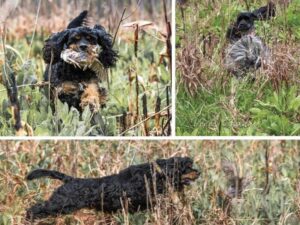
Unveil the Cocker Spaniel’s remarkable qualities as the epitome of a “total package” breed, embodying type, size, balance, and function.
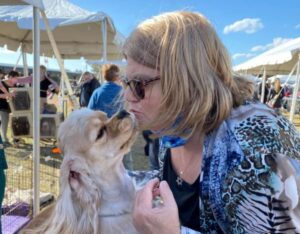
Judie Posner is the breeder behind Encore Cockers. Read about the kennel’s beginnings, the sires, the dams, the puppies, and much more!

Learn about the genetic causes of primary angle closure glaucoma in American Cocker Spaniels, the most common form of glaucoma in dogs.

Judith Webb is the breeder behind SoundView Spaniels. Read about the kennel’s beginnings, the sires, the dams, the puppies, and more!
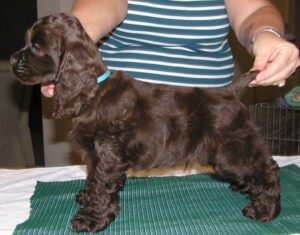
Annette Norris is the breeder behind DreamShadow Cockers. Read about the kennel’s beginnings, the sires, the dams, the puppies, and more!
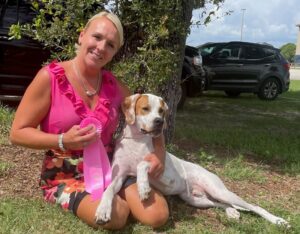
Suzanne Bambule is the breeder behind Monarch Pointers and Cocker Spaniels. Read about the kennel’s beginnings, sires, dams, and more!

Dan Sayers is the Editor-in-Chief of SHOWSIGHT digital and print publications. He received a B.S. from Drexel University where he studied interior architectural design. His professional career has allowed him to develop his planning, problem-solving, and project management skills, which were employed in the office, educational, and financial sectors. While working as a project manager, he earned a Graphic Design Certificate from the University of the Arts and began creating ads for many of America’s top-winning show dogs. Through this work, Dan became Editor-in-Chief of the nation’s first online-only dog show publication. His current role expands on this experience and broadly extends to cover the sport of dogs in Companion and Performance events as well as all aspects of Conformation.
Dan is a long-time member of the Irish Water Spaniel Club of America and is the organization’s current AKC Delegate and Archivist/Historian, as well as a club-approved Breed Mentor. From 2000-2010, he was the club’s AKC Gazette Columnist. He breeds Irish Water Spaniels under the Quiet Storm prefix and has judged the IWSCA National Specialty Sweepstakes twice. Dan is a member of the Morris and Essex Kennel Club as well as the Dog Writers Association of America, which recognized his illustrations in the award-winning canine compendium, the Encyclopedia of K-9 Terminology.
The best way to ensure a long and happy relationship with a purebred dog is to purchase one from a responsible breeder. Not sure where to begin?
Contact the National Parent Club’s Breeder Referral Program, which is listed on the AKC Breeder Referral Contacts page.
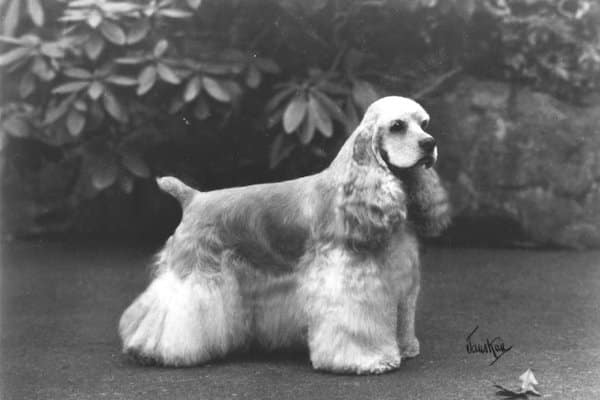

"*" indicates required fields
Showsight Magazine–the world’s most influential purebred dog publication since 1992. Each issue reaches a global audience dedicated to preserving the history and health of purpose bred dogs. Filled with award-winning editorial focused on news and insights from the dog show community, top breeders, handlers, AKC Judges, and more!